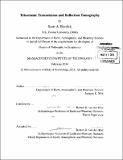Teleseismic transmission and reflection tomography
Author(s)
Burdick, Scott A. (Scott Anthony)
DownloadFull printable version (30.70Mb)
Other Contributors
Massachusetts Institute of Technology. Department of Earth, Atmospheric, and Planetary Sciences.
Advisor
Robert D. van der Hilst.
Terms of use
Metadata
Show full item recordAbstract
The aim of seismic tomography is to determine a model of Earth properties that best explain observed seismic data. In practice, the limitations placed on our observations and computational capabilities force us to make a number of decisions about the scales and parameterizations of models, the nature of the data considered, and the approximations to wave propagation that connect the two. This thesis will consider three divergent approaches to seismic tomography spanning different representations of Earth structure at different scales, using different parts of the teleseismic wavefield, and solving the inverse problem with different approximations to the wave equation and different optimization methods. In choosing each of these approaches, we address two major decisions that influence the tomographic process: First, what relative value do we place on an less approximate treatment of wave physics versus the ability to incorporate as much information as possible in our inversion? Second, how can we use novel data to better constrain smooth seismic structure in regions that were previously unresolved? The first project presents a global ray-theoretical P-wave model that encompasses millions of traveltime picks. In this inversion, the addition of data from the dense USArray Transportable Array to global catalog data allows us to image the structure of the Eastern United States with unprecedented resolution and make a robust evaluation of the spatial scales of the heterogeneity. The second project develops a finite frequency approach to turning wave transmission tomography using a computationally efficient one-way wave propagation on curvilinear coordinates. The use of overturning coordinate systems allows for the application of wave equation tomography to phases previously unused in other oneway schemes. The final project presents a novel approach to wave-equation teleseismic reflection tomography using free surface multiples. The use of these multiply reflected phases helps to localize heterogeneity in the model to within layers of Earth structure. This project spans the final two chapters and includes the theoretical developments and an inaugural application to SsPmp data from the Hi-CLIMB array in Tibet.
Description
Thesis: Ph. D. in Geophysics, Massachusetts Institute of Technology, Department of Earth, Atmospheric, and Planetary Sciences, 2014. Cataloged from PDF version of thesis. Includes bibliographical references.
Date issued
2014Department
Massachusetts Institute of Technology. Department of Earth, Atmospheric, and Planetary SciencesPublisher
Massachusetts Institute of Technology
Keywords
Earth, Atmospheric, and Planetary Sciences.